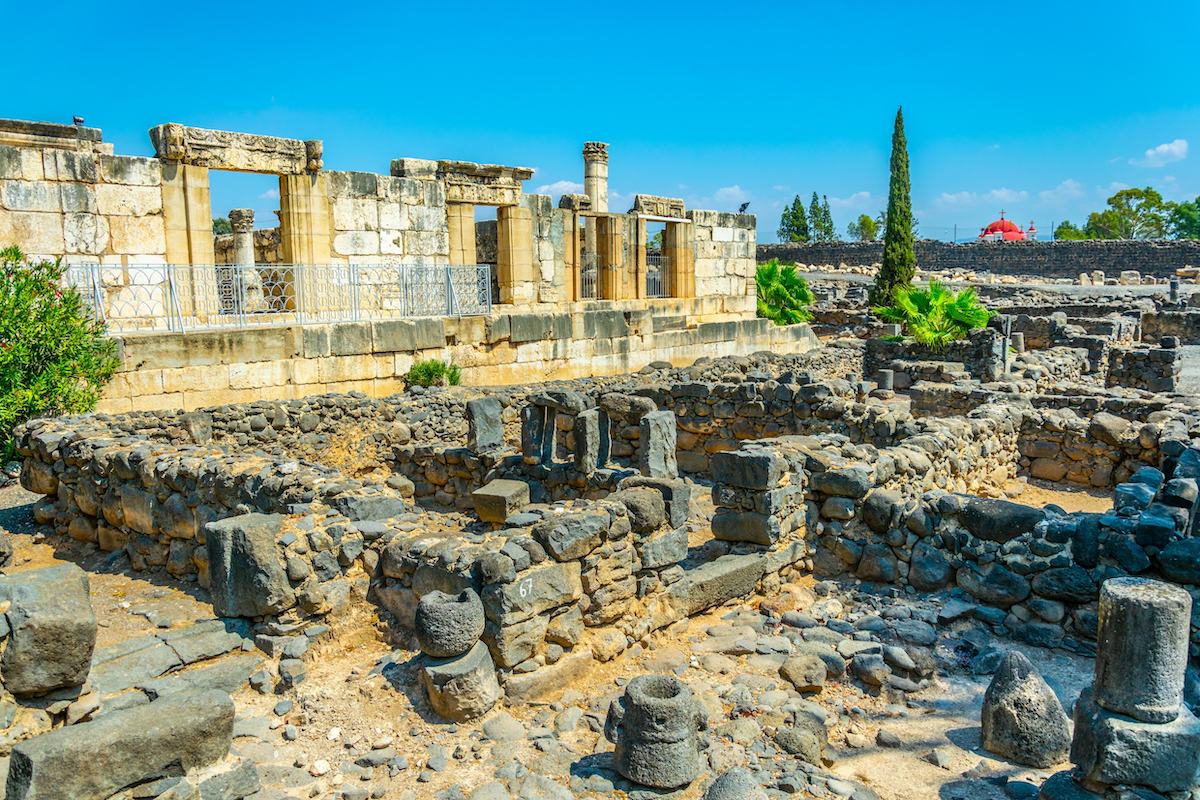The Crossroads: Exploring the geography of Israel

Israel has a unique geographic position at the crossroads of continents and historic empires.
It’s right in the middle, connecting Africa, Asia and to a certain degree Europe, as well. It’s a land bridge and also the cradle of civilization.
If we go back to the time of Abraham, the land of Canaan that God promised him was right there between the two ancient empires of Egypt and Mesopotamia. Since these civilizations were aware of each other and traded with each other, some of the most important trade routes in the world went straight through Israel. In fact, they still do!
This makes Israel a desirable territory for empires and gives one explanation for why so many wars were fought over this piece of land.
A mere century ago, the British Empire sought to control Palestine in order to have a land bridge to India. Once India became independent in 1947, the Brits had no reason to stay in the Middle East and simply left, giving the Jewish community the opportunity to declare an independent Israel in 1948.
Before that, Britain fought the Crimean War [1853-1856] to keep Russia away from the Middle East, and before then, in 1799, Napoleon tried to control the area for France. And before that, we had the Ottomans and, before them, the Mamluks, the Mongols, the Persians, the Crusaders, the Romans … well, you see where this is going.
You might have noticed that I’ve used three different names for the area in this article so far: Canaan, Israel and Palestine. Those are just a few of the names people have called our country.
Under the Crusaders, the land was known as the Kingdom of Jerusalem, and during the divided Kingdom of Israel, after King Solomon’s reign, only half the area was called Israel. The other half was called Judah.
It’s almost as complicated as the difference between Britain, Great Britain, England, the United Kingdom and the British Isles. Some of those are included within others, some are not, and some have one historic and a different modern meaning.
The big empires at the time of Abraham – Egypt, Sumer and the Indus – were all river civilizations. Water security provided by the rivers enabled them a stable food resource, and as long as there was an empire that protected land and personal property, the empire could easily also extract taxes, and grow larger and mightier.
Areas like Israel, where just a small drought could cause famine, became dependent on trading with the empires.
We see how Abraham arrived in Canaan for the first time and immediately went on to Egypt, the moment he realized there was famine in the land. A few generations later, Jacob sent his children to Egypt to get food because of famine.
When the children of Israel went through the desert from Egypt to the Promised Land, God made a point of this. In this new land, they would not have the Nile, they would be dependent upon rain – on God’s blessing!
“The land you are entering to take over is not like the land of Egypt, from which you have come, where you planted your seed and irrigated it by foot as in a vegetable garden. But the land you are crossing the Jordan to take possession of is a land of mountains and valleys that drinks rain from heaven. It is a land the Lord your God cares for; the eyes of the Lord your God are continually on it from the beginning of the year to its end.” (Deuteronomy 11:10-12)
The trade routes that go through Israel connected Israel to the rest of the world. The Romans knew one of the best known routes as “Via Maris” or the “Way of the Sea” (Matthew 4:15). It went from Egypt along the Mediterranean coast through Gaza, up to Haifa, and then turned inland through the Jezreel Valley along Megiddo and to Tiberias, and then through Magdala and Capernaum, to Hazor, the Golan Heights and on to Damascus.
From Damascus, travelers could continue straight towards Haran and either turn left toward the Anatolian Peninsula and the Hittite empire (today’s Turkey) or turn right to Mesopotamia and Babylon.
The caravan that bought Joseph from his brothers and brought him as a slave to Egypt probably traveled along this road.
But did you notice? Capernaum was along this route. How do you think so many people from around the Galilee area heard about Jesus? The hearsay about him would not have gone out as quickly if he had stayed in Nazareth.

Capernaum might have been a small fishing town, but it also lay right on the trading route, and people went through it every day. (That’s probably also why there were local tax collectors, like Matthew, in the town). This made Capernaum the perfect base of operations for Jesus. It was not a huge center with important people, so he could focus on the regular and simple people, but it still enabled the Gospel to spread far and wide.
The Romans accomplished two significant things in their empire, which, unbeknownst to them, helped spread the Gospel after Jesus’ death and resurrection. They built roads throughout their empire; they enforced Pax Romana, making traveling safer than it had ever been, and they allowed free movement within their empire.
Paul the Apostle could easily move from Jerusalem to Antioch to Rome to Spain without any Roman border guard asking him “business or pleasure?” along the way.
Israel was on the outskirts of the Roman Empire, but the trade routes made it so well-connected that it only took a few centuries for strong Christian congregations to be established in Rome, Ephesus, Antioch and Alexandria.
Later, Rome moved to Constantinople, which became a “more important” junction between the continents, seen by many as the new Jerusalem in the Christian Byzantine empire. (Justinian I is said to have said, “Solomon, I have surpassed you” when he built the Hagia Sophia).
With the arrival of Islam and the Arab occupation of the Middle East, Palestine became connected with Damascus and Baghdad, and less with Greece and Rome. As Jerusalem was only the third holiest city of Islam, the land was neglected for many centuries, and alternative trade routes like the Silk Road became more prominent.
But the Christian religious interest in Jerusalem and the need to safeguard the safety of pilgrims traveling to Jerusalem eventually sparked the Crusades, which established the short-lived kingdom of Jerusalem for a couple of centuries.
Then, the Mamluks came and tied Palestine back to the Muslim world, making Israel a part of the largest and strongest empire at the time – until the Mongols wrecked it.
With the Age of Exploration and the European discovery of the seaway to China around Africa, and the discovery of America a few centuries later, the Mediterranean and Middle East became less interesting. Europe could now trade directly with China and didn’t need the Middle East anymore. There were new lands, new conquests and new colonies to establish.
Britain, France and Spain were better geographically positioned for trade with the new worlds, and they emerged as world powers. The importance of the trade routes through Israel diminished.
Or did it?
With Napoleon’s conquest of Egypt and arrival to Jaffa, the other world powers started scrambling and competing to invest in the dying Ottoman Empire, especially in Palestine. A weak Ottoman Empire had, for the past centuries, enabled the Brits easy access to the colony in India, but if Russia or France would get too much influence – that could spell disaster for British interests.
Once again, Israel’s unique geographic location played a significant role in disputes between world empires as they fought the Crimean War over who would get jurisdiction over the holy sites in Jerusalem. The first postal system, modern roads and railroads in Israel were all built by these different European powers.
In WWI, Britain conquered the Ottoman Empire, making sure to keep Iraq, Jordan and Palestine, and built a long oil pipeline from Iraq to the refineries in Haifa, while giving France the less interesting Syria and Lebanon. And then, as we said, once India gained independence – it didn’t take long for the Brits to leave the Middle East altogether.
Even today, Israel’s unique position makes it stand out. Israel has an extreme variety of nature relative to its small size. I’ve been told that there are places in the U.S. where you can drive for days and still see nothing but prairie. Israel is a mere 8-hour drive from north to south (230 miles), and yet you have everything from snowy mountains and lush vegetation with waterfalls in the north, to dry deserts with camels and coral reefs in the south.
From the lowest place on earth in the east, to the flat coastal plain of the Tel Aviv area. Why this extreme variety? Because it’s at the crossroads of Africa, Asia and Europe, between two seas, with connections to two oceans, and also because it’s a land bridge between the climates of the desert, the sea and the mountains.
It is a land the Lord your God cares for; the eyes of the Lord your God are continually on it from the beginning of the year to its end.

Tuvia is a Jewish history nerd who lives in Jerusalem and believes in Jesus. He writes articles and stories about Jewish and Christian history. His website is www.tuviapollack.com













